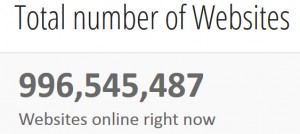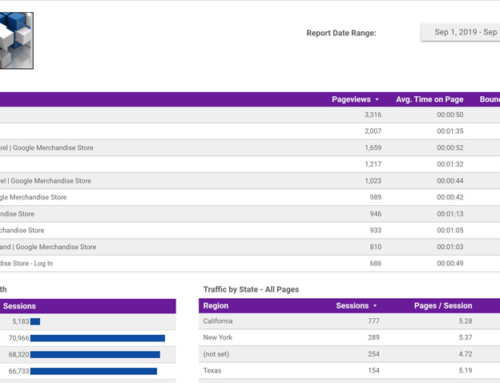Implementing a Content Management System (CMS) is not a one-size-fits-all situation and requires a comprehensive analysis to arrive at the best decision. This article provides a high-level overview of WordPress and Business Catalyst that can be helpful when deciding which CMS to use. Keep in mind that both systems are constantly evolving to meet market demands and to keep up with the latest trends in technology industry.
Total number of websites
 As of March 1, 2016 at around 5:20 pm CST the total number of websites was 996,545,487 according to Internet Live Stats. Business Catalyst claims to host over 120,000 active websites which works out to about 0.01% of the total number of websites.
As of March 1, 2016 at around 5:20 pm CST the total number of websites was 996,545,487 according to Internet Live Stats. Business Catalyst claims to host over 120,000 active websites which works out to about 0.01% of the total number of websites.
As of December 2015, according to DMR Stats/Gadgets approximately 25% of the websites on the Internet are running on WordPress which translates to a little over 249 million, but again, that is a stat from December 2015. In 2014 alone approximately 18 million WordPress sites were added.
Business Catalyst
Founded as “GoodBarry” in 2004 and acquired by Adobe on August 31, 2009 when it was renamed “Business Catalyst”. The following information is provided by Adobe Business Catalyst. Some of the statistics do not distinguish between live sites and trial sites.
- 120k+ active sites
- 175k+ partners
- 10TB served each month (does not distinguish between live sites and trial sites)
- Partnerships grow by tens of thousands a month
- Doesn’t account for partners that leave
- Doesn’t distinguish between paid partners who are typically developers and free partners who are typically designers
- 3 million email messages processed each month
- 6 million products on e-commerce system
- 40 million CRM records
Business Catalyst has many advantages including integrated services that reduce the number of login IDs needed meaning that the same ID is used for hosting, content management, online store, email marketing, etc. The built-in web form builder is tightly integrated with most of the system and can be customized fairly easily by developers. On of March 1, 2016 Business Catalyst announced the “Widget Factory” which will initially provide 11 extensions provided by BC and available to all BC developers at no cost reducing the code development required in certain instances.
WordPress
Founded in 2003, WordPress was designed as a blogging platform first. Not everyone needs an online store, but nearly everyone needs a top-notch blogging system. The foundation is so well implemented that even if a blog is not required developers frequently use the blogging code to extend WordPress by adding custom post types allowing for easy development of photo galleries, member directories, and even online stores. Being an open-source platform means that there are literally hundreds of developers around the world working to make it better and you or your web developer have access to their work for free and can customize it as you see fit. As of March 9, 2016 there are over 43,000 plugins available with over 1.2 million downloads listed on the WordPress web site.
Feature comparison of WordPress and Business Catalyst
| WordPress | Business Catalyst | |
|---|---|---|
| Blog | Blog engine from the beginning and considered to be one of the best | Included but fairly crude compared to WordPress |
| Ecommerce | Requires 3rd party extensions. Included with many themes and easily integrated with other systems. Shipping support requires add-ons to the ecommerce extension which incurs additional cost and maintenance. Support for discount codes and gift vouchers usually requires add-ons to the 3rd party extensions. | Included and fairly capable. Extension and integration requires programming via APIs. Support for most major shipping carriers is built-in. Support for gift vouchers and coupon codes is included. |
| Content Management System | Has evolved to be fairly powerful. Easy to maintain and very flexible and extendible. Sharing and reusing content generally requires 3rd party extensions. | Part of the core software from the beginning. Easy to maintain and very flexible. Being nearly fully integrated with the rest of the components makes sharing and reusing content very easy. |
| Customer Database | No real capability built in. Third party extensions add this ability but can be difficult to manage and many times, it is not linked to other third party extensions that may be in use. | Part of the core software from the beginning. Very easy to maintain and very well integrated with other built-in components. Default fields are limited but easily extended via custom CRM forms. |
| Email Marketing | Requires 3rd party extensions. Constant Contact and Mail Chimp plugins are available that provide varying levels of functionality. Constant Contact email templates are very restrictive and not responsive. Mail Chimp templates are much more flexible and are responsive. | Included with the core software and is fairly robust. No integration with Constant Contact or Mail Chimp is currently available and not in the development roadmap. Custom templates can be designed and managed within the BC admin interface and externally developed templates can be uploaded providing support for responsive design. |
| Contact Forms | Requires 3rd party extensions which might not integrated with other 3rd party extensions in use. | Built-in web form builder is very powerful, moderately customizable and fairly well integrated with the BC core software. Built-in support for workflows, payment processing and Google ReCaptcha anti-spam tool. |
| Event Management | Requires 3rd party extensions. Very powerful plugins exist that make it easy to provide a specialized solution but generally incur additional costs and maintainence. | Built-in basic booking system and event calendar. Supports payment processing and is integrated with the core software |
| SEO | Requires 3rd party extensions. Yoast SEO may be one of the best and makes it very easy for clients to improve their SEO quality. Requires external analytics and reporting tools such as Google Analytics. | Built-in support in page editor and most modules for SEO support but does not provide any guidance on a per-page or per-post basis, requiring a higher level of SEO knowledge. Built-in basic analytics and reporting but still should rely on Google Analytics. |
| Reporting | Relies on 3rd party extensions or external reporting | Built-in dashboard provides one week high-level traffic statistics. Activity feed reports one week of activity that can include secure zone logins, sales, orders, email campaign activity and form submissions. |
| Hosting | Self-hosted | Business Catalyst only |
| Software Type | Open-source | Software as a Service (SaaS) proprietary |
| Membership Support | Requires 3rd party extensions | Basic support provided via integrated CRM, custom web applications, multiple secure zones and secured content. |
| Menus / Navigation | Built-in basic navigation builder. Integration with site template and customization is dependent on 3rd party extensions and web site developers | Built-in basic navigation build but is somewhat more flexible than WordPress. Customization and integration requires web site developers. |
| Media Support | Supports most common media types but not well integrated requiring copying and pasting links to media other than images (i.e. DOC, PDF, XLS). Management of uploaded media is very cumbersome. | Supports most common media types. Linking to the media files is very simple via “Media Downloads” and/or the WYSIWYG page editor. Built-in file manager makes uploaded media management very easy. |
| Web Applications | Requires 3rd party extensions which are tend to be very limited or highly specialized. | Built-in Web App module makes it easy to generate form-based applications for posting and sharing various types of content. Integration with built-in secure zones modules make it easy to build a members-only area. Through custom programming Web Apps can provide access to many other areas of the core software. |
We hope this information is helpful as you evaluate the different platforms for building and maintaining your web site. Speaking of “maintaining your web site,” we’ll discuss just that in an upcoming blog post so please check back frequently. While this article outlines the differences in capabilities between WordPress and Business Catalyst, it’s also important to know what your maintenance costs and/or efforts are going to be.








